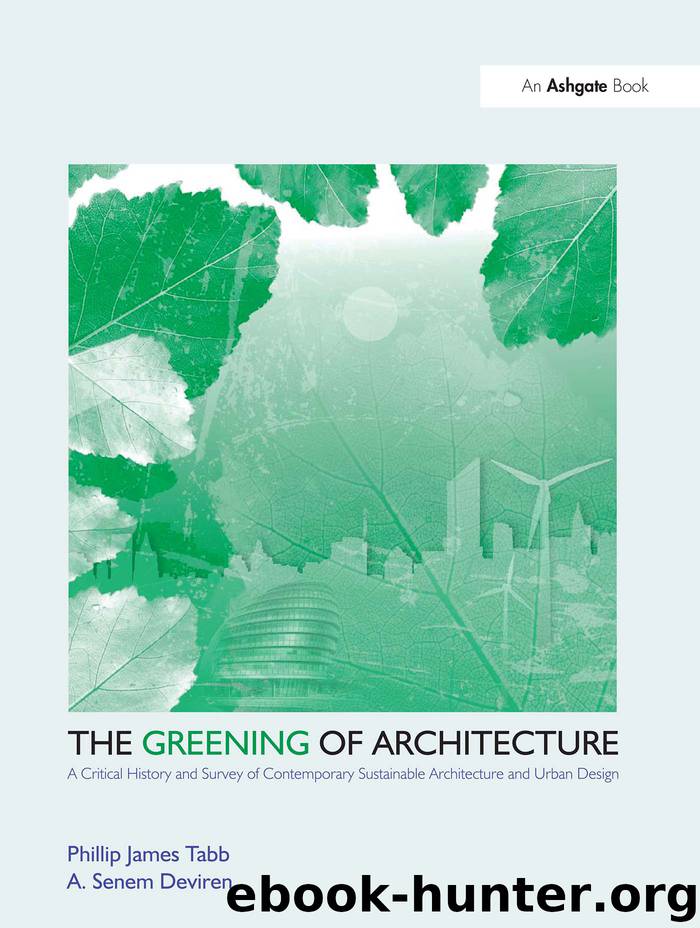The Greening of Architecture by Tabb Phillip James; Deviren A. Senem;

Author:Tabb, Phillip James; Deviren, A. Senem;
Language: eng
Format: epub
Publisher: Taylor and Francis
Published: 2016-03-14T04:00:00+00:00
4.6 Critical Regionalism a) Brion Tomb b) Mississauga civic centre (permission Kirkland Partnership, lnc) c) MiT Rehan House (© chant Avedissian / Aga Khan Award for Architecture) d) Sydney opera House (courtesy “Shutterstock”)
POSTMODERN GREEN ARCHITECTURE
Deconstruction, a development of postmodern architecture, began in the late 1980s and was brought into public attention with the Museum of Modern Art’s 1988 exhibition Deconstructivist Architecture in New York City. The exhibition featured works by Frank Gehry, Daniel Libeskind, Rem Koolhaas, Peter Eisenman, Zaha Hadid, coop Himmelb(l)au, and Bernard Tschumi. Deconstruction grew from post-structural philosophy and literary criticism, and its development in architecture was characterized with fragmentation, distortion, dislocation of architectural elements, and an interest in surface or skin. A few, though tenuous, connections can be made relative to the benefits of deconstruction to the development of green architecture at this time. Both shared a desire to break from modernism’s constricting simplicity and overly reduced language. Where deconstructivism sought unpredictability, confrontation, disconnection from context, and to some degree chaos, postmodern green blended regional context and contemporary programs to the linage of vernacular forms. Neither deconstruction nor green postmodern embraced ornament, yet both had precarious traces of modernism. Deconstruction subverted functionalism and postmodern green reacquired it for environmental purposes.
Relative to the greening of architecture, deconstructivism had mixed influences. Even though it was considered a development of postmodernism, on one hand the exciting and complex designs reinvigorated a waning discipline that was disenchanted with both modernism and postmodernism—over rationality versus superficiality. Deconstruction provided a brief creative outlet from the regressive with explorations with non-rectilinear shapes, fragmentation, distorted forms, and infatuation with design and qualities of surface. They tended to express through more public and high-profile building typologies, such as museums, monuments, and arts facilities, which often was the case for the designs of Gehry, Miralles, coop Himmelb(l)au, Koolhaas and Hadid. Deconstructivitism produced designs that were exciting, spontaneous and often chaotic, and they were generally well received by the public and academic institutions.24 on the other hand simultaneously, they were complex with inherent energy inefficiency and largely were an expression of conspicuous consumption. Complex forms usually produced greater surface areas generating higher levels of heat loss or gain, additional corners that were susceptible to thermal bridging, increased volumes with greater heating, and cooling and ventilating loads. Complex shapes and geometry usually resulted in higher material costs and increased construction waste. The complex compositions fortuitously allowed, in some instances, the inclusion of sustainable technologies that otherwise might have been considered obtrusive and aesthetically disharmonious to more traditional, as well as modernist, designs.
A common ground can be seen with the example of the Solar House in Breisach-am-Rhein, Germany (1992) by Thomas Spiegelhalter. It was a complex and sculptural arrangement of architectural volumes juxtaposing renewable energy components and exterior space-defining elements. This project was referred to as “Vila Deconstructa.”25 its systems for using ambient energy and rainwater collection, its integrated conservatory/greenhouse, and its indeterminate form gave flexibility that it could grow and change with the lives of its occupants. While this
Download
This site does not store any files on its server. We only index and link to content provided by other sites. Please contact the content providers to delete copyright contents if any and email us, we'll remove relevant links or contents immediately.
| Automotive | Engineering |
| Transportation |
Whiskies Galore by Ian Buxton(41518)
Introduction to Aircraft Design (Cambridge Aerospace Series) by John P. Fielding(32880)
Small Unmanned Fixed-wing Aircraft Design by Andrew J. Keane Andras Sobester James P. Scanlan & András Sóbester & James P. Scanlan(32564)
Craft Beer for the Homebrewer by Michael Agnew(17921)
Turbulence by E. J. Noyes(7688)
The Complete Stick Figure Physics Tutorials by Allen Sarah(7133)
Kaplan MCAT General Chemistry Review by Kaplan(6581)
The Thirst by Nesbo Jo(6429)
Bad Blood by John Carreyrou(6266)
Modelling of Convective Heat and Mass Transfer in Rotating Flows by Igor V. Shevchuk(6217)
Learning SQL by Alan Beaulieu(6021)
Weapons of Math Destruction by Cathy O'Neil(5813)
Man-made Catastrophes and Risk Information Concealment by Dmitry Chernov & Didier Sornette(5636)
Digital Minimalism by Cal Newport;(5369)
Life 3.0: Being Human in the Age of Artificial Intelligence by Tegmark Max(5174)
iGen by Jean M. Twenge(5148)
Secrets of Antigravity Propulsion: Tesla, UFOs, and Classified Aerospace Technology by Ph.D. Paul A. Laviolette(4969)
Design of Trajectory Optimization Approach for Space Maneuver Vehicle Skip Entry Problems by Runqi Chai & Al Savvaris & Antonios Tsourdos & Senchun Chai(4836)
Electronic Devices & Circuits by Jacob Millman & Christos C. Halkias(4737)
